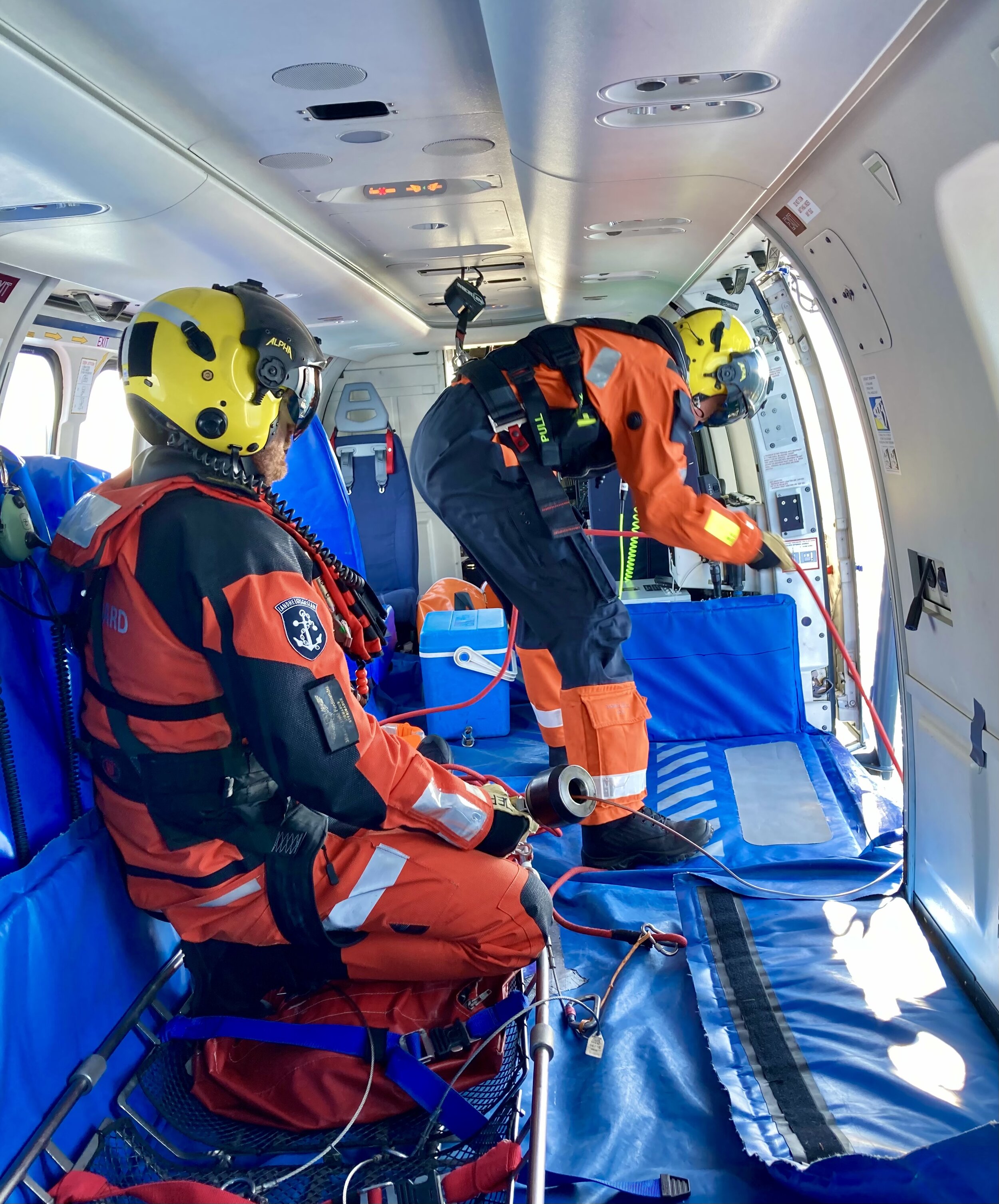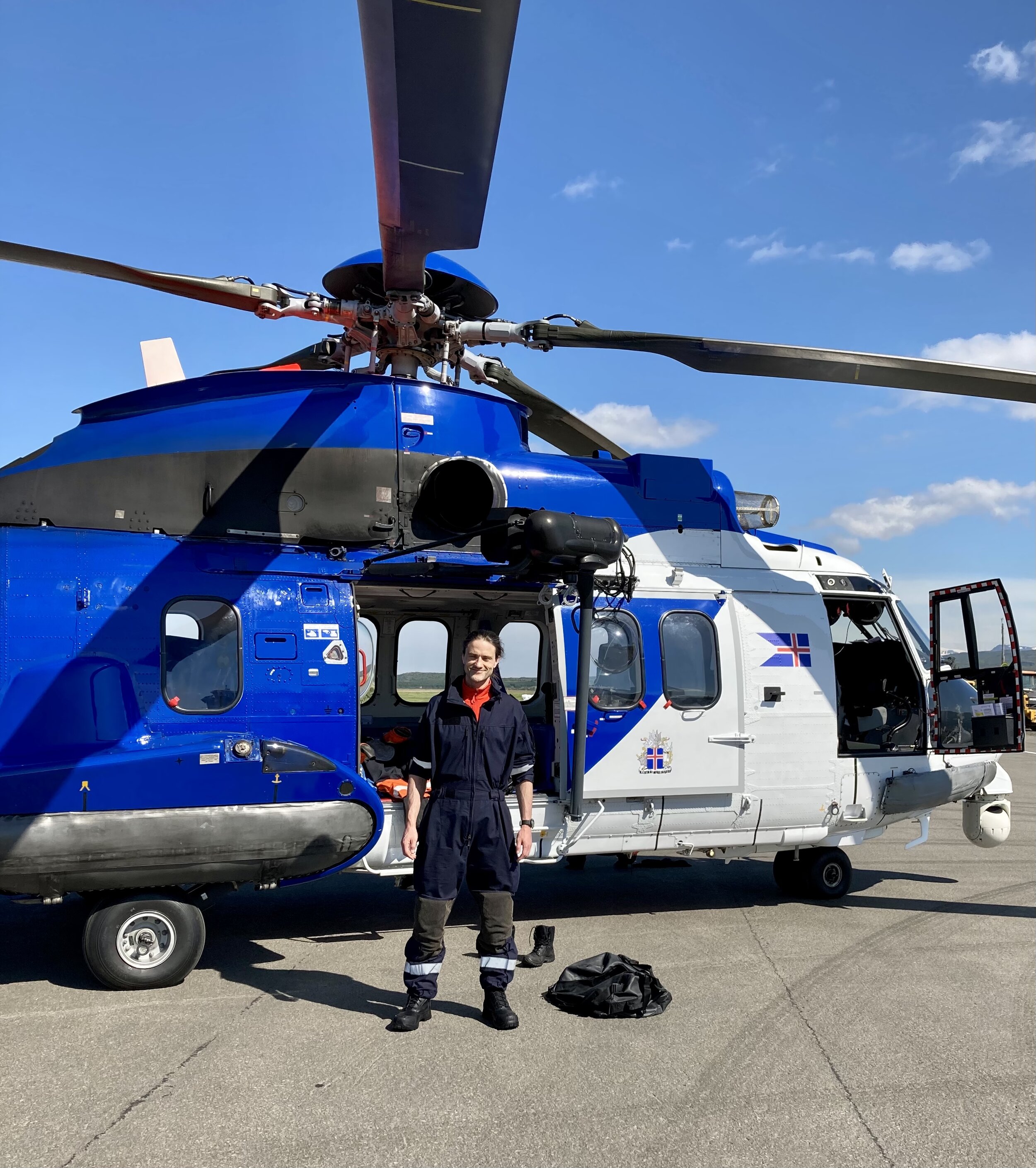An Insight into Iceland’s Emergency Medicine and Pre-Hospital Care Systems
Dr Ross Archibald, ST6 Emergency Medicine, South East Scotland Deanery
This week began with an opportunity I couldn’t pass up. The Icelandic Coast Guard had scheduled a helicopter mission to the far east of the country in order to undertake boat and water rescue exercises with one of the coast guard vessels. I was asked if I’d like to go along as the doctor just in case anything happened(!) The journey was one I won’t forget – a 1000km round trip across the centre of the country, passing over breathtaking scenes of glaciers, mountains, canyons, rivers and black lava fields.
After re-fuelling at a small airport in a town called Egilsstaðir, we made our rendezvous with the coast guard vessel in the waters off the east coast. The crew ran through a series of live winch rescue drills, involving casualties from a life boat and open water, whilst the pilots skilfully maintained position just above the boat. We had a good day for it, with few clouds and moderate winds buffeting the helicopter. As I’m sure you can imagine, the Icelandic weather is not always this favourable – the coast guard maintain preparedness to undertake missions across the country 24 hours a day and in almost all weathers. During winching activity, where the side door of the helicopter was open, the crew switched to largely non-verbal and hand gesture-based communication due to the noise levels. It was clear that there was an innate understanding between crew and that these were well drilled activities, essential in high pressure but low volume rescue work. I enjoyed another stunning flight home and felt I’d had a great insight into some of the challenges involved in the Icelandic Coast Guard’s search and rescue operations.
I spent the remainder of the week back on terra firma with Reykjavík’s ambulance service. Each day began at 0720 in the emergency services headquarters with a crew briefing and handover, followed by kit and vehicle checks. There are four ambulance bases in the Reykjavík area, each shared with the fire service. The central station where I was based also houses police and coast guard operations. During the week, I had the chance to tour all four of the bases and was introduced to the teams working in each. Once again, there was an excellent standard of facilities available to staff. All bases were kitted out with a full gym, sauna, comfortable sleeping rooms and staff living areas, well-equipped kitchens and a dining room where a healthy free meal was provided at lunchtime. We could certainly learn a thing or two about staff wellbeing here and I could see why they were keen to show me around!
The central emergency services base in Reykjavík also houses Iceland’s only emergency call handling and dispatch facility. I was able to spend some time with the staff in this facility, who manage all emergency service calls in the country. A notable positive of the co-location of the emergency service in this base is that the police service are right next door to the dispatch room, which helps with planning a response to incidents, particularly where a multi-agency response may be required. All emergency calls (made by dialling 112 in Iceland) are initially taken by a non-clinical call handler, of whom there are generally two or three working at any one time. In a similar fashion to ambulance calls in Scotland, they work with a script of questions, quickly establishing the clinical problem, the location of the caller and assigning a priority to the call. They are also able to request an ambulance at an early point in the call for immediately life threatening issues. Calls then appear on the screen of the dispatcher across the room (also non-clinical), of whom there are generally one or two working at any one time. They are able to activate or refine the emergency service response within a few mouse clicks, and can directly dispatch all emergency services from police through to fixed wing air ambulance. As touched on previously, they are not able to directly dispatch the Icelandic Coast Guard helicopter – this is generally done following a conversation with their team first. The system in place for categorising ambulance calls according to priority is similar to the one in use by the Scottish Ambulance Service (SAS). There have been recent efforts in Iceland to further optimise call prioritisation, with one of the local EM consultants involved in revising some of the scripts used by the call handlers.
Like Reykjavík’s emergency department, the integrated dispatch centre was operating with a custom made IT system, developed by one of the local ambulance staff. It appeared to be very user friendly, using computer-aided dispatch, satellite-based emergency service vehicle locating and detailed country-wide mapping data to facilitate optimal dispatch actions. For example, dispatchers are able to bring up surveillance camera feeds to give information about road conditions or a traffic accident to the responding teams. They are also able to remotely open certain gates on rural roads to allow response vehicles to pass! In rural areas where ambulance coverage is limited, they can task local GPs or members of the public to certain incidents and have a direct communication link to the small medical huts which dot the remotest corners of the country. To help prepare GPs for this aspect of their role, a specific course focused on pre-hospital care and rural emergencies has been devised and run by anaesthetics and emergency medicine physicians in Reykjavík. There is as yet no organisational equivalent to BASICS Scotland, which works in conjunction with SAS and The Sandpiper Trust to equip volunteer doctors, nurses and paramedics to act as first responders in rural areas of Scotland.
During the week, I rode along in one of the ambulances tasked to higher triage category calls, staffed with an EMT and paramedic team. There are generally two ambulances operating at each of Reykjavík’s bases during the day – one for higher priority calls staffed with a paramedic and an experienced EMT team and one for lower priority calls staffed with a more junior EMT team. The scope of practice and autonomy of EMTs and paramedics here increases with grade and has broad equivalence to our own pre-hospital services, albeit with a few differences with job titles and available kit and medications.
The patients we saw had clinical problems spanning a broad and familiar range including: palpitations, breathlessness, unresponsiveness, seizure, chest pain and musculoskeletal injuries. There was good co-ordination on display between ambulance crews and hospital staff – crews would generally pre-alert the nurse in charge of the relevant receiving clinical area by phone, allowing cubicle space to be organised and staff to be allocated in time for arrival. As well as providing a primary response, we also facilitated the hospital transfer of patients received from the fixed wing air ambulance servicing the rural parts of the country. I will talk more about this in Part 4. I found these shifts really valuable in giving a better appreciation of the pre-hospital phase of patient care here, but also through the opportunity for shared learning across our disciplines, which I think there is room for more of both here and at home.
Notable here is the wide range of additional training and roles available to EMTs and paramedics. Most of them are also fully trained in fire rescue, something they all seemed to value in providing added variety and job satisfaction. Furthermore, there are various additional specialised emergency service teams which paramedics are able to join and train for. One of these is the water rescue team, which recruits from within the paramedic team. Initial training for this is two months full time, followed by regular refresher training once on the job. The water rescue equipment is housed in a separate unit in the emergency services headquarters and includes a specialised ambulance with diving equipment, a rescue boat and equipment for ice rescue. Each member of the team has their own personal kit, which is checked and rotated daily and maintained in a state of readiness for a call out.
There is also a specialised mountain rescue team within the ambulance service, the equipment for which is housed at one of the other stations I visited in the Reykjavík area. The kit available includes a specialised ambulance, all terrain quad bikes and equipment for mountain and snow rescue. In addition to this there is a specialised team and large dedicated response vehicle tasked to building collapses, the threat of which arises from the earthquake and volcanic activity in Iceland. One of the paramedics I worked with also serves on the specialised tactical response team, which requires him to train and dispatch alongside the police tactical team to respond to firearms incidents and terrorist attacks. As I observed in Selfoss last week, morale and job satisfaction amongst the Reykjavík paramedics was high and I could understand why!
This has been another great week and has really helped in piecing together how the pre-hospital systems operate here and where they are headed. Thank you to all the Reykjavík ambulance staff for making me welcome and part of the team, with a special thanks to the paramedics Helgi, Birkir, Christian and Gunnar.




